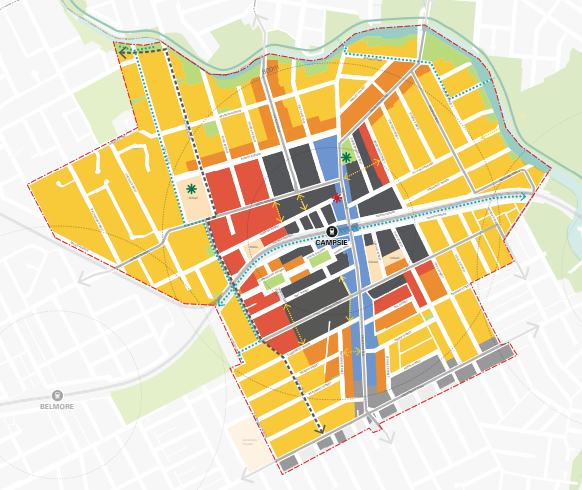Upzone the Metro
The NSW Government has announced they will complete the conversion of the Bankstown line to a metro service.
Eleven stations between Bankstown and Sydenham will receive trains every four minutes during the peak, with travel times to the city up to ten minutes lower than the current heavy rail.
We need to seize this opportunity to build dense, walkable communities near public transport, and address the housing crisis.
Summary of our recommendations:
Density along the Bankstown line should be uniform, rather than biased towards the western suburbs.
We recommend 10-12 storeys above all metro stations, stepping down to four storeys 1.2km from the station.
Mid-rise should be permitted by default within 400m of stations elsewhere on the network, stepping down to four storeys 800m from the station.
Density should be uniform
In 2016, the previous government put forward a rezoning for this line that was heavily tilted to the west.
For example, in Bankstown at the western end of the line, dense high-rise and mixed-use development was slated for about 600m from the station, and mid-rise across most of the rest of the precinct:
Campsie, slightly east of Bankstown, had igh rise out to 400m, 8 storey mid-rise out to 600m, and no single dwelling zones in the precinct at all.
Compare this to Hurlstone Park, just east of the Cooks River which got a few 5-7 storey mid-rises within 200m of the station.
And one stop east at Dulwich Hill has a similar pattern, but with a few 8 storey mid-rise streets near the Dulwich Grove light rail stop.
This makes no urban planning sense. The stations further east are a shorter commute to the city and have higher land values, so many more people are desperate to move there. The densest development is planned not around the metro stop itself, but one kilometre away at Dulwich Hill light rail - coincidentally, on New Canterbury Road.
The reason for the soft approach becomes obvious when we look at the number of objections received during the process in each suburb:
In spite of the impact of these upzonings being extremely concentrated in the western suburbs, complaints came almost exclusively from the eastern suburbs. The explanation for this lies in demographics differences on either side of the Cooks River, as reflected in the most recent Census at the time:
This rezoning was abandoned completely after lobbying from local councils (principally Inner West Council), with the plan being left up to the councils themselves. They still have not completed the rezoning.
It is critical that we do not repeat this mistake. We must ensure that density is evenly distributed, including to the eastern suburbs closer to the city. These suburbs have shorter commutes and are suffering from a loss of multicultural character because of their failure to build enough housing.
Rezoning template
It is critical that this rezoning provides both the supply required to address the affordability crisis and a diversity of housing forms to suit different households and preferences.
Our proposed template for all stations along the line is a uniform rezoning as follows:
10-12 storeys out to 400m from the station (11% of land area)
6-8 storeys out to 800m (33% of land area)
3-4 storeys out to 1200m (56% of land area)
This provides dense high-rise precincts close to the station fanning out to mid-rise and missing middle housing over the bulk of the precinct around the station.
Mixed-use should be permitted throughout, creating many points of interest and walkable communities, with the population concentration supporting a wide range of businesses and services.
There should be significant investment in cycling and pedestrian infrastructure to ensure easier access to the station for those both inside and outside the precinct.
The exception will be Sydenham, which has unique aircraft height and noise constraints and is not suitable for much except low-rise medium density like townhouses and manor houses.
Elsewhere on the network
Removing the Bankstown line from the City Circle will unlock significant capacity on other lines like the Airport and Inner West line. This will lead to more frequent and more reliable trains across the Sydney Trains network.
Accordingly, we should seek to zone for more capacity around all stations on the Sydney Trains network. The template for this would look as follows:
6-8 storeys out to 400m
3-4 storeys out to 800m
This would provide new energy for tired local shopping strips while permitting suburbs across the city to organically evolve over time.
What can you do?
There is not currently a consultation open, but Sydney YIMBY will be organising around this issue and we’ll need your help. If you want to get involved, become a member.






